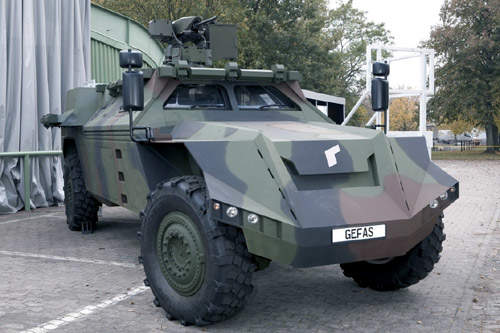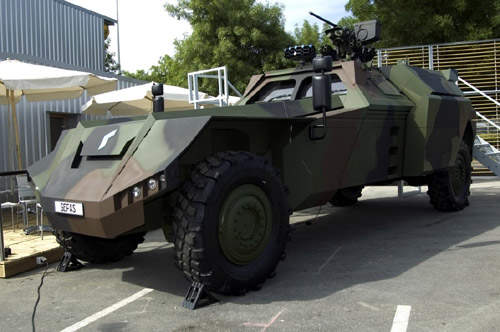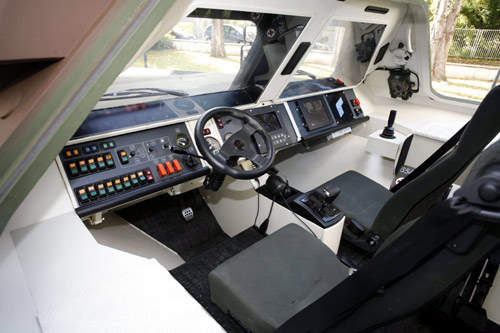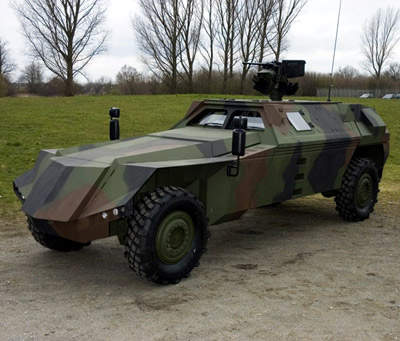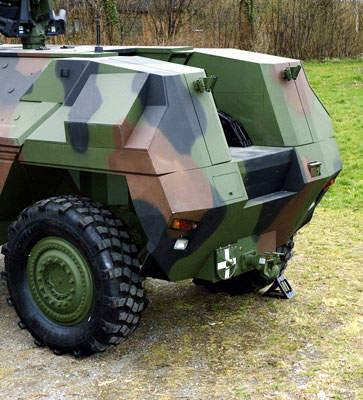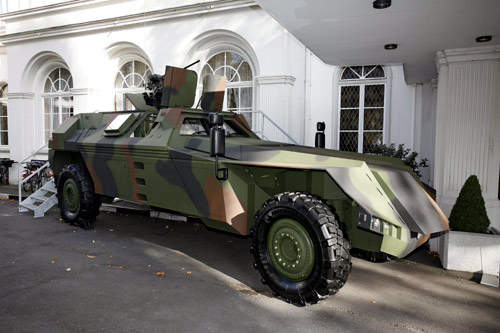The Gefas (Geschütztes Fahrzeug System) protected vehicle system is a family of protected vehicles developed by Rheinmetall Landsysteme GmbH and a group of industrial partners.
The vehicle has a high level of protection for a vehicle of its weight class, the 4×4 version weighing 17,500kg. The Gefas vehicle is of modular design and can accommodate a range of retrofit kits for roles including armoured patrol vehicle, convoy escort, command, reconnaissance or air defence vehicle. The main module can carry a six-man crew with their complete equipment.
Gefas armoured vehicle development
The industrial team, led by Rheinmetall Landsysteme at the company’s main development centres in Kiel and Kassel, comprises MTU Friedrichshafen GmbH, ESW GmbH and STW Sensor-Technik Wiedemann GmbH. Other companies taking part in the programme include IBD Deisenroth of Lohmar, Germany and Ireland’s Timoney Technology Ltd.
Design work was started in 2003 and the first Gefas vehicle was unveiled at the June 2008 Eurosatory equipment show in Paris.
The vehicle can be airlifted in a C-130 or A400M transport aircraft. Two 4×4 variants can be transported in one A400M aircraft.
The vehicle has a maximum road speed of 100km/h and a range of 1,000km. The all-wheel steering provides a turning radius of 6.8m which allows manoeuvrability in restricted spaces such as urban areas. For cross-country deployment the vehicle can ford to a depth of 1.5m and manoeuvre on gradients up to 60%.
Gefas modular armoured vehicle design
The modular design allows the elements to be mixed and matched to form different vehicles. In its basic configuration, the vehicle consists of a main module, a power module and two axle modules with front and rear modules carrying the headlights and tail lights. If the power pack module is placed behind the main unit, a cargo area or platform space allows the installation of weapons or sensor systems. If required, future weapons can be mounted on additional new modules.
The main module comprises a carrier structure containing the suspended safety cell. The safety cell is attached exclusively to the vehicle’s roof. A large zone of free space in the floor area under the safety cell ensures that it remains undamaged if a landmine explodes under the vehicle.
Armour protection
The vehicle provides protection against anti-tank mines, improvised explosive devices (IEDs), rocket-propelled grenades and small arms fire. A V-shaped hull deflects the upward mine blast away from the cabin. The structure of the Gefas vehicle is based on a suspended safety cell crew compartment with high-grade armour protection which provides full 360° protection.
The vehicle’s sides and undercarriage consist of large slanting surfaces which deflect the shockwaves caused by blast mines and roadside IEDs. Additional armour plating on the carrier structure and safety cell provides added protection from ballistic threats and explosively formed projectiles. Rheinmetall and IBD Deisenroth Engineering are developing appliqué armour modules. Reactive and active armour versions are also planned as options.
Gefas armoured vehicle variants
The Gefas family of vehicles includes 4×4, 6×6 and 8×8 configurations. The structures are based on common subsystems and the mission systems and modules are connected by a standard military data bus.
The 4×4 variant has a gross weight of 12.5t and a maximum combat weight of 17t. The 8×8 vehicle has a gross weight of 20t and is capable of towing a 5t trailer.
Gefas Weapons
The vehicle can be fitted with a remote-control weapon station armed with a general purpose machine gun or 40mm grenade launcher. Other weapon systems can be fitted.
The Gefas air defence radar version uses a 6×6 Gefas vehicle with rear-integrated power pack module. The configuration provides sufficient space to integrate a 12m tactical radar mast for detecting small, fast, steeply ascending targets. The 4×4 variant configured as a guided missile platform consists of two axle modules, a two-man main module and a power pack module integrated at the rear; a special module forms the interface to the mobile launcher.
The Gefas air defence platform consists of a 4×4 basic vehicle with an additional 4×4 rear vehicle or trailer. The rear vehicle or trailer carries an air defence turret, e.g. the Skyranger system made by Oerlikon Contraves, which can be used for engaging both air and ground targets. As an option the vehicle can also be armed with guided missiles.
Cabin
The crew compartment is of a suspended safety cell structure which accommodates the driver, commander and four troops. The seats are suspended rather than of a floor-mounted conventional design.
Countermeasures
The vehicle is fitted with a suite of electro-optical sensors with downstream image processing, including laser sensors linked to onboard countermeasures including smoke and obscurant generators which can be deployed automatically or by manual control.
The vehicle can be fitted with an optional high-power jamming transmission system to jam radio-controlled signals for the detonation of explosives. A high-power electromagnetic system (HPEM), mounted for example on a Gefas escort vehicle, can prevent the detonation of IEDs by mobile phone or radio or can be used to induce premature detonation of roadside IEDs at a safe standoff distance.
Engine
The vehicle is powered by a MTU 4R890 military four-cylinder diesel engine which provides 410kW. The drive unit contains the engine, an electrically powered cooling unit, an air filter system and an electric power generator. The electric power generator is developed and manufactured by ESW.
As a basic force protection measure, the Gefas provides minimum mobility even if only one axle module is functioning. The axles are fitted with STW electric motors that will power the vehicle for a short distance if the main engine fails or is shut down.
The front and rear axles are driven and are identical. The vehicle is fitted with run flat tyres, which have a central tyre inflation system and central pressure control.
The vehicle is fitted with a double wishbone suspension system supplied by Timoney of Ireland.

